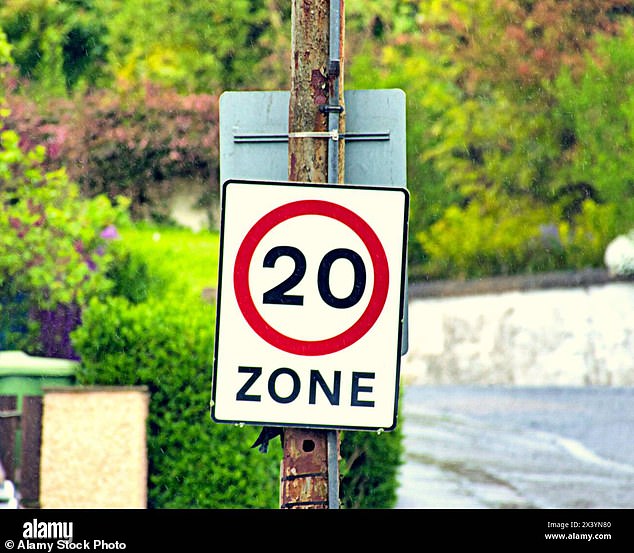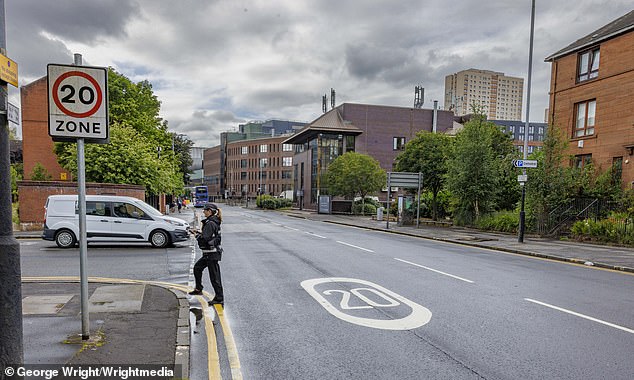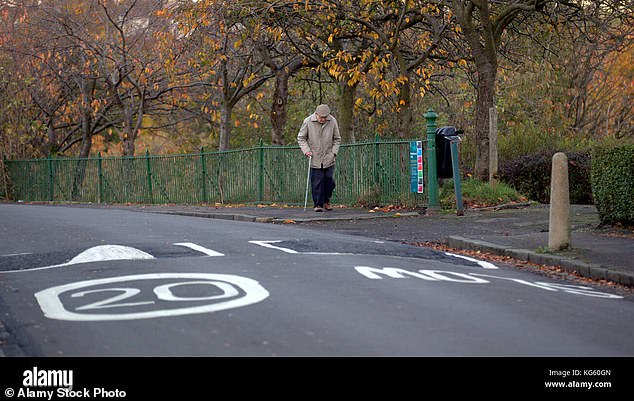Controversial 20mph zones on the streets of Scotland’s biggest city have failed to protect pedestrians, new research has shown.
Cash-strapped Glasgow City Council is spending £8.6 million to extend the scheme into dozens of neighbourhoods across the metropolis.
Officials claim it will save lives, justifying the money spent and the inconvenience to drivers.
But now a study by Nottingham University has found the speed crackdown has so far been ineffective in cutting serious injuries to those struck by vehicles.
Published in the journal Accident Analysis & Prevention, it concludes: ‘The Glasgow 20mph scheme… has not significantly altered the disproportionately high risk of pedestrians being involved in severe collisions.’
Hugh Bladon, of the Alliance of British Drivers, said: ‘It’s utter madness for Glasgow to be spending almost £9 million on something that will achieve very little or nothing at all.
’There are any number of reasons why there are collisions with pedestrians. The council would be better off trying to get through to those people who walk round with phones stuck to their ear, not looking where they’re going – or those staggering into the road blind drunk.
‘The imposition of 20 mph zones seems to be a fetish among local authorities, but as this study shows, it’s not something that will work everywhere. It’s horses for courses.

SNP-led Glasgow council is spending a fortune turning almost every street into a 20mph zone

Hugh Bladon of the Alliance of British Drivers said the scheme was ‘madness’
‘Councillors just like to be seen to be doing something, anything, however, they are wasting their time trying to force people out of their cars.
‘If 20 mph is the right speed to drive, motorists will drive at 20 mph. But if 30 mph is safe, why is there this mania for imposing restrictions on them?’
The SNP-led local authority plans to spend a fortune turning almost every street under its jurisdiction into an ultra-low-speed zone.
But this week, Glasgow admitted it’s facing a financial crisis despite recently hiking council tax for its residents by 7.5 per cent.
Further inflation-busting rises would still leave it needing to find an extra £80 million by 2028 to balance the books, mainly due to a surge in numbers of asylum seekers and homelessness applications by refugees.
The latest research, by engineering scholars at Nottingham and the Aristotle University of Thessaloniki in Greece, studied traffic accidents in Glasgow and Edinburgh.
It took government data for the six years either side of the 20mph zones’ start date in 2016 and looked at single-vehicle collisions involving pedestrians or cyclists.
The number of accidents has fallen in both cities, though this was partly due to the Covid-19 pandemic slashing traffic volumes on the roads between 2019 and 2022.

The 20mph crackdown in Glasgow is expected to reach £8.59m, almost twice initial estimates

A new study shows the zones have not ‘significantly altered’ the risk to pedestrians
In Edinburgh, there is evidence that motorists are driving at lower speed on residential streets and taking that habit on to busier A-roads where collisions tend to cause more serious injuries.
But in Glasgow, the study suggests the opposite is the case with faster speeds on the many arterial routes cutting through the city continuing to set the tone in 20 mph zones.
The study states: ‘Compliance with the new 20mph speed limit in the city centre may be lesser, particularly given the size and proximity of surrounding arterial roads, which could induce spill-over effects.’
Additional risk factors were identified in both cities.
In Edinburgh, there are signs that extensive redesign of the city centre has caused confusion, leading to a significant rise in collisions on footways and verges.
Meanwhile in Glasgow, drivers under 26 and over 65 are now a risk factor in accidents, suggesting many in those age brackets are simply ignoring the 20mph speed limits.
There was no evidence in either city of cyclists now being safer.
The study concludes: ‘In short, the 20mph network in Edinburgh appears to have significantly reduced the absolute number of vehicle–pedestrian collisions, but the majority of this reduction is attributable to collisions resulting in slight injuries.
‘[However], the 20mph scheme in Glasgow has not significantly altered the existing vulnerability of pedestrians on city centre streets.’
Most of Edinburgh’s roads are now 20mph zones, barring the major arterial routes which fan out from the Old and New Towns.
However, in Glasgow the scheme is concentrated mainly in the centre and West End with numerous other localised pockets.
Consultants have advised expanding its reach to take in around 5,200 of the city’s 5,700 streets.
The Daily Mail revealed in February that the crackdown’s cost is expected to reach £8.59m, almost twice initial estimates, with taxpayer-grant funding also coming from Bristol-based pro-cycling lobby group Sustrans.
Wales introduced a national 20mph limit on urban roads two years ago, in the face of public opposition.
The Government claims it has saved 200 lives, but it cost £34 million, has increased journey times and landed 134,000 drivers with speeding fines.
Some councils – including in Wrexham and Newport – are now choosing to turn many of their streets back to 30mph zones.
Glasgow city centre’s Low Emission Zone, introduced two years ago, has raised £1.8m in fines from motorists, but council data last week showed improvements in air quality, partly due to the introduction of more electric buses.
A council spokesman said: ‘This report indicates a citywide 20mph speed limit in Glasgow may yield greater safety equality for pedestrians.
‘Glasgow is progressing with the expansion of 20mph limits in built-up areas as part of our commitment to improve road safety, protect vulnerable road users, and create healthier, more liveable communities.
‘Our implementation plans reflect best practice, drawing on lessons from other cities while tailoring the scheme to local conditions.
‘The roll-out will be accompanied by signage and complementary measures including a public awareness campaign to support compliance and maximise safety benefits.
‘We’ll closely monitor [the zones’] impact to determine their effectiveness.’